 |
|
Tata Motors announced its financial results for the third quarter of fiscal year 25 (Q3 FY25), revealing a significant drop in consolidated net profit. The company reported a 22 percent year-on-year decline, reaching Rs 5,451 crore, a figure that fell short of analyst expectations. This underperformance can be attributed primarily to two key factors: weaker margins across various segments and a slowdown in sales volume at its luxury vehicle subsidiary, Jaguar Land Rover (JLR). While the overall revenue from operations did see a modest 2.7 percent year-on-year increase, reaching Rs 1,13,575 crore, this growth was insufficient to offset the impact of reduced profitability. The decline in profitability is evident in the company's EBITDA (earnings before interest, tax, depreciation, and amortization) margins, which contracted by 60 basis points year-on-year to 13.7 percent. This underscores the challenges Tata Motors faced in maintaining its profit margins despite a slight increase in overall sales.
A deeper look into the segmental performance reveals a mixed bag of results. Jaguar Land Rover, while achieving record quarterly revenue of GBP 7.5 billion (a 1.5 percent year-on-year increase), saw its EBIT margin improve to 9 percent—its highest in a decade. However, the EBITDA margin contracted significantly by 200 basis points to 14.2 percent, indicating pressure on profitability. Profit before tax (before exceptional items) for JLR also declined to GBP 523 million from GBP 627 million in the same period last year. The company attributed the sequential growth to improvements in its supply chain, but expressed caution about the prevailing market demand, especially in China. The Commercial Vehicles (CV) segment experienced an 8.4 percent year-on-year decline in revenue, reaching Rs 18,431 crore, due to a combination of weaker volumes and an unfavorable product mix. However, EBITDA margins for this segment showed improvement, rising by 130 basis points to 12.4 percent, thanks to material cost savings and benefits from government initiatives like the Production Linked Incentive (PLI) scheme.
The Passenger Vehicles (PV) segment also experienced a revenue decline of 4.3 percent, reaching Rs 12,354 crore. Despite this, EBITDA margins improved by 120 basis points to 7.8 percent, driven by cost-cutting measures and PLI incentives. The company highlighted positive growth in its electric vehicle (EV) sales in the personal segment, with a 19 percent year-on-year increase. However, fleet sales were negatively impacted by the expiry of FAME II subsidies. Overall, Tata Motors' profit before tax (before exceptional items) fell marginally to Rs 7,700 crore, a mere Rs 75 crore less than the same period last year. Automotive free cash flow stood at Rs 4,700 crore, reflecting improved volumes. The company also benefited from a reduction in finance costs, which shrunk by Rs 760 crore to Rs 1,725 crore, due to a decrease in gross debt. This reduction in debt signifies a positive step towards improved financial health.
Looking ahead, Tata Motors expects a gradual improvement in demand, driven by factors such as increased infrastructure investments, the launch of new products, and stable interest rates. JLR anticipates a further improvement in wholesale volumes in the fourth quarter, but maintains a cautious outlook on overall demand, particularly in the Chinese market. PB Balaji, Group CFO of Tata Motors, expressed confidence in the company's fundamentals and predicted another strong performance for the year, despite external challenges. The company's overall performance in Q3 FY25 presents a mixed picture. While certain segments showed resilience and even growth in certain metrics, the overall profit decline highlights the challenges faced by the company in navigating a complex market environment. The impact of the JLR slowdown and margin pressure remain significant concerns that will likely need to be addressed in the coming quarters to ensure sustained profitability.
